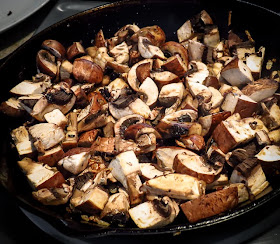What defines a great hash? Several years ago I posted (link) my view that any really good hash would:
- be crisp with some browned, caramelized bits,
- offer soft textures along with the crunch,
- incorporate cooked meat, potatoes, onions and roasted vegetables, and
- include a seasoning tang or some serious chile heat.
I was not kidding earlier this week (link) when I said I really, really craved a skillet of hash, and that the next batch would have bacon. This second skillet of hash was inspired by JoytheBaker's post with it's meltingly delicious mushroom base. I didn't change much, just added some fresh thyme plus the all-important bacon and its rendered fat, used small white onions instead of shallots and finally, omitted her recommended cooked egg topping. Swap the 'shrooms out for potatoes and you have the base ingredients for my Oven-Roasted Sprouts! No wonder I was so ready to try this mushroom version of hash.
The hash was not a fast-prep dish. It takes a while for the mushrooms to release their liquid, cook down and brown nicely, but you don't want to rush through this step. Steamed 'shrooms are not as tasty or pretty as their slow-cooked, caramelized kin. Most of my time was spent working with the onions and Brussels sprouts, not a difficult chore but I was slowed down by trying to use my left hand for chopping/slicing those little round globes. (No blood was spilled during this event.)
The result? we enjoyed this vegetable combination at lunch, thinking it more of a side dish than breakfast fare. Perhaps serving an egg on top would have made the difference there. The rich, mellow taste of the bacon-flavored mushrooms shone in this recipe, and that alone was enough to win me over. The sprouts came along for the ride, a pleasant sidekick to the spotlight-grabbing 'shrooms. Crisp bacon crumbles provided a fine topping to each serving, but a tiny internal voice queried, "Where's the crunch of crispy potato that makes this hash?"
 |
| Photo: These large cremini were chopped into 8 wedges each. |
 |
| Photo: Sprout pinwheels will separate a bit when cooked . |
 |
| Photo: Sizzling crisp bacon left a scattering of browned bits in the pan. |
 |
| Photo: Cremini fill the skillet, ready to cook in bacon fat... yum! |
 |
| Photo: Cremini turn golden brown as they release their juices and caramelize. |
 |
| Photo: Lid the pan briefly to heat the Brussels sprouts. |
 |
| Photo: The seasoned Mushroom and Brussels Sprouts Hash is almost ready to serve. |
Mushroom and Brussels Sprout Hash... with Bacon
Serves 22 strips thick-sliced smoked bacon (NOT maple-glazed)
1 tablespoon olive oil (if needed)
1 dozen tiny onions, small dice (or several small shallots)
6 large cremini mushrooms, rough chopped
1 large clove garlic, minced
3 to 4 cups shredded Brussels sprouts
1 teaspoon fresh thyme, chopped (or 1/4 tsp dried thyme)
juice of a small lemon (2 to 3 tablespoons), zest optional
salt and pepper to taste
Prep the vegetables:
- Peel and chop the onions, discarding any papery skin.
- Clean the mushrooms with a damp paper towel (do not rinse them under running water).Quarter or cut them into bite-sized chunks.
- Clean each sprout, slice off the dried-out stem end and discard any discolored outer leaves. Slice into thin rounds horizontally.
- Mince or use a garlic press on the garlic clove and rough chop the thyme.
- Use a medium cast iron skillet to cook the bacon until it renders its fat and crisps up. Remove the bacon and set aside but leave the drippings and crispy bits in the pan.
- Add the diced onion to the pan and cook over medium heat until softened and beginning to brown. Add the mushrooms with a generous sprinkle of salt and cook until they release their liquid and begin to brown. Stir or flip with a spatula occasionally to insure most 'shrooms contact the pan. Add the garlic and fresh thyme, stir in and cook until fragrant (about one minute).
- If the pan looks dry at this point, add a bit of olive oil. Add the sprouts and fold in or toss to combine with the mushrooms. Cover and cook for 2 or 3 minutes to warm the mixture. Remove the lid, increase the heat to medium high and cook until the sprouts just begin to crisp and the mushrooms are browned.
- Remove from the heat. Sprinkle the lemon juice over the top and fold or toss to mix. Plate and scatter crisp bacon bits over each serving.
- The hash is best served warm and enjoyed immediately, though I would be tempted to reheat and eat some the next day if there were any left over.
- I ate my serving without any extra condiments. As usual, RL topped his with some additional seasoning, this time he chose Heinz 57 Sauce.
- The dish rated two thumbs up, but it may be a while before Brussels sprouts make another appearance at the table. (Two days in a row was too much for one of us.)



















